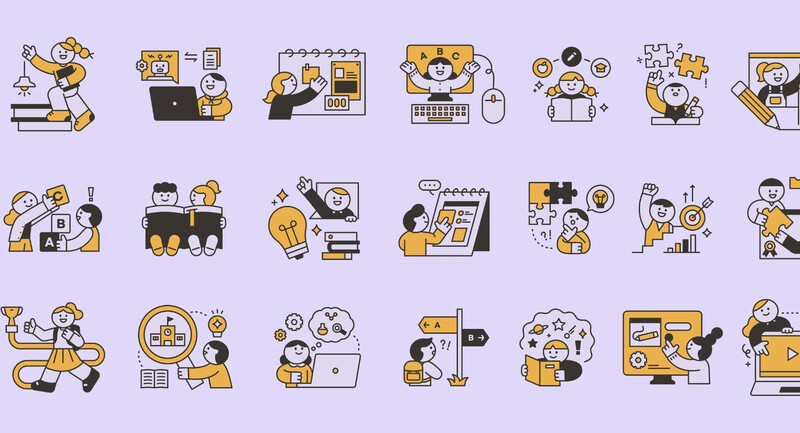You notice a student stumbling through a problem or concept and your first impulse is to "rescue" him. Maybe it's because he's frustrated and on the verge of giving up, says ASCD author Robyn Jackson. But "we also rescue kids because it's the most expedient way to move on to the next kid. Especially when several students are asking for help."
In a classroom that emphasizes productive struggle, "the biggest thing teachers can do is resist the urge to rescue students," says Jackson. "When teachers help too much, they reinforce the idea that it's about getting it right and not about the struggle of learning." Eventually, students won't put forth the effort at all because it's "not being rewarded or emphasized."
Setting up an environment where students use help effectively requires some finesse. But research points to a few key moves that can turn help seeking from a perceived deficit into a valuable learning strategy.
A Social Minefield
Help seeking is "inherently academic and social," says Sarah Kiefer, a University of South Florida professor who studies help-seeking behaviors. Many students worry that asking for help will "put their academic and social competence on the line." Essentially, they're afraid of "looking dumb."
"For a lot of kids, the classroom is a social minefield," she says, especially in middle school. Kiefer's research shows that adolescents are less likely to engage in adaptive help seeking—asking for just enough information or clues to solve a problem—"with the motive that they want to learn." Instead, they might opt for expedient help seeking (simply asking for the answer so they can move on) or avoidant help seeking (not asking for help when they need it).
Students' "social goals" can influence their help-seeking habits. In a 2016 study published in the Journal of Applied Developmental Psychology, Kiefer found that 6th graders who strive for popularity or dominance (having control over their peers) are more likely to engage in expedient than adaptive help seeking.
"When kids are entering middle and high school, the idea of what it means to be cool or popular is changing," says Kiefer. At the elementary level, kids are more inclined to value responsibility, hard work, and intelligence. But those qualities are downplayed in middle school. Suddenly, "putting forth effort is a really vulnerable thing."
Stuart Karabenick, research professor at the University of Michigan, suggests that students will be more inclined to seek help in a supportive, "mastery-oriented environment" that values failure and struggle as part of the learning process.
Students in classrooms that work toward a growth mindset are less concerned about their ability, especially relative to their peers, notes Karabenick. "It's not competitive. It's about me and how I can get better."
Practice and Repeat
The goal of strategic help seeking is for students to "ask for ways to solve problems rather than ask for answers."
Karabenick recommends talking about the and "letting [students] describe how they feel about seeking help in your class." Then have them role-play, in pairs or small groups, what to do in different situations when they're stuck.
Teachers should recognize their own patterns, too, notes Karabenick. One study of college students found that when teachers gave short answers to complex questions, students were less likely to ask for help over time.
"Just saying, at the beginning of class, to 'ask when you don't understand' is not enough," he says. Follow-through matters.
"Respond to questions with complete answers or explanations, or defer answering until later when you have time," Karabenick advises. "Your actions communicate how seriously you take seeking help. That's what [students] pay attention to."
Strategies, Not Solutions
At Two Rivers Public Charter School in Washington, D.C., where a "culture of grappling" is encouraged, teachers set norms for help seeking at the beginning of the year. They "talk explicitly about the need to ask for help and then model that in a low-stakes environment," says Jeff Heyck-Williams, director of curriculum and instruction. All students, from grades preK–8, learn what it means to "be kind, be specific, [and] be helpful."
The aim is to "ensure that the kids are grappling constructively, not just looking for a crutch," explains Heyck-Williams. "We don't just step in and give kids answers or steps to solving a problem, but we direct them with questions."
These questions "point students in a more fruitful direction and keep them engaged in the work," he says. They also send the message that "the intellectual lift is on them."
One student recently struggled with a math problem involving conversions between cubic inches and cubic feet. No matter how many times he tried, he arrived at a different answer than his peers. To keep him persisting, Heyck-Williams asked a few questions to determine how he got his answer, then followed up with, "Why did you multiply by 12?" and "Where did that 12 come from?"
"Just asking those guiding questions helped him look at his work more deeply and understand 'Oh, I should've been multiplying by 12 cubed [instead of] just multiplying by 12.'"
Students also learn "how to give help without giving away the answer." Sometimes they have trouble deciding what to ask, says Heyck-Williams, but at least they understand that, "If I start with questions, then the person I'm helping is going to have to engage in a way that they wouldn't if I was just saying, 'Do this' or 'do that.'"
"The learning process is about the struggle, and you don't want to take that away from someone."
The Struggle Is Real
A struggle is like a composition, suggests Jackson, with many layers at play. "You have to know when you need help, and that's a big challenge in [most] classrooms."
A crucial skill for students is being able determine whether they are struggling productively or destructively. In a destructive struggle, students should ask for help. But in a productive struggle, they should try to "get unstuck on their own."
In her book, How to Support Struggling Students (ASCD, 2010), Jackson suggests providing "break glass strategies"—tools that students can turn to in case of emergency—to help in times of productive struggle. These could be a process students memorize for working through a problem, an online discussion group where they can post questions to peers, or just showing students how to use resources ahead of time (p. 73).
These strategies could also be specific to an assignment or unit. If students are stuck on an essay prompt that asks them to do a rhetorical analysis, they could write one paragraph that examines "ethos," one that examines "logos," and one that examines "pathos." The structure "helps them get their ideas flowing and get unstuck in their writing," says Jackson.
Having an arsenal of strategies to lean on, and knowing when to use them, "overcomes a lot of help seeking that's really just, 'I'm struggling and I'm uncomfortable.'"
Familiarize your students with the stages of help seeking through repeated practice and role-playing (the process may not always fall in order). - Determine whether there is a problem - Determine whether help is needed/wanted - Decide whether to seek help - Decide on the type of help (goal) - Decide on the source of help (e.g., teachers, peers, online help) - Solicit help - Obtain the help - Process the help *Source: Stuart Karabenick, University of Michigan*
Ask for "Input"
Some students may be reluctant to concede that they've hit a wall in the first place. "When you ask for help, you're basically saying 'I'm empty, I'm out of options,'" admits Jackson. But if you reframe that request as, "I'm using these options and they're not working," or "I'm using an option but I need help in how I use the option," then students will see it differently.
"It doesn't threaten their image of themselves as learners—it actually reinforces it," she says.
As a classroom teacher, Jackson lessened the stigma with "non-examples," a concept based on the Frayer Model (a graphic organizer for building vocabulary). "There are no wrong answers," she told students. Instead, "there are examples of the right answer and non-examples of the right answer."
When a student gave a "wrong answer," she wrote it on the board and exclaimed, "That's a great non-example!" Then she asked the class to turn it into an "example." The first time, "we spent five minutes playing around with it and trying to figure out what the key error was. The kids were thinking and struggling, and we were modeling how to work our way out of mistakes."
With practice, students learned to offer "non-examples" when stumped. Or they shared, "I have a non-example but I'm having a hard time changing it to an example." Such a shift makes it less about the student and more about the work, explains Jackson. Students are able to say, "I'm struggling productively and I could use your assistance."
Teachers can lower the stakes by circulating and offering help discreetly as students work independently or in small groups, adds Heyck-Williams. Or students can ask a question anonymously with tech tools or write down a question as their exit ticket and place it in a box in the classroom. By doing this regularly, you're "norming that not only is it OK to ask questions, it is expected."
Also, celebrate the small successes and the "movement that students make," advises Heyck-Williams. "Even though they may not have solved a problem, talk about what they learned so they don't feel completely defeated and move toward a fixed mindset."
It's about "creating a culture where it's normal not to [immediately] get the answer," he confirms.
"We should be conveying that effort is important, but it's in the service of progress and learning," reminds Carol Dweck, Stanford psychologist and Mindset author. "There are other equally important things—like finding the strategies and seeking input."
Help seeking should never be taboo, she insists. "Maybe if we called it 'seeking input' rather than 'asking for help,' kids would go for it more," says Dweck. "Kids could say to the teacher, 'I think I need some input, now.' Or the teacher [could] say, 'Tell me when you need some input.'"
"Everyone needs input, at some point."
Negotiate the Balance
Supporting the help-seeking process, while encouraging productive struggle, is like a fire drill—"we have to teach it and practice it," notes Jackson.
That goes for educators, as well. "If we're always giving kids steps to solving a problem and not letting them grapple and figure out how to solve it themselves, then they aren't going to be prepared to do that effectively [in the future]," says Heyck-Williams.
"The more you normalize struggle," adds Jackson, "the more kids are going to be willing to come to you for help."








